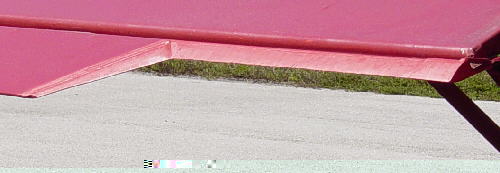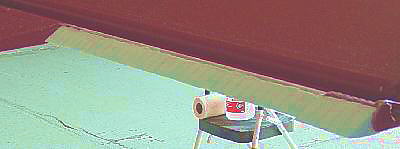|
|
|
and Feathering in the Taper on the Ailerons.
|
 Additional foam pieces were glued to the vertical tapered surface that goes from the trailing edge to the torque tube. After all pieces were in place, the foam was smoothened into shape with a wall board joint sanding sponge.
Additional foam pieces were glued to the vertical tapered surface that goes from the trailing edge to the torque tube. After all pieces were in place, the foam was smoothened into shape with a wall board joint sanding sponge.
The foam was covered with organza (a very thin and light polyester material). Long narrow strips of the organza was ripped. On the top surfaces I used masking tape to hold the material in place and painted the fabric with latex paint cut to one half with windshield wiper fluid. It wets well, but I had troubles with getting the fabric straight and smooth. When the paint dried, the masking tape was removed and the fabric trimmed close to the trailing edge of the fairing. The leading edge of the fabric was trimmed so that it could be rolled over the leading edge of the torque tube, and paint was applied to stick it to the tube. Several coats of paint had to be applied to fill in the fabric weave. When I tried the same approach on the bottom of the fairing surface, it was too difficult. And so I changed the approach and dabbed uncut latex directly onto the foam and patted the fabric into place. Then more uncut latex was brushed on over the unpainted portions of the fabric. Wrinkles and air bubbles appeared but they could all be chased to the front and rear edges and the fabric could, if necessary, be realigned. The surface tension of the uncut latex was so high that it would suck up the fabric, and I did not have to remove the wing to do the job. |
 |
|
The completed fairing. For both ailerons, calculations indicate the following savings:
At 50 mph -> saves 0.47 hp Because portions of the fairings are in the high velocity air passing through the propeller, these calculations are probably conservative. In addition to hp savings, propeller noise is also reduced.
|
 Foam pieces were epoxied to the aileron torque tube. No epoxy was used inbetween the foam pieces because if it squeezed out to the surface, it made sanding the foam to its final shape more difficult. Usually it tears out a small hole in the foam.
Foam pieces were epoxied to the aileron torque tube. No epoxy was used inbetween the foam pieces because if it squeezed out to the surface, it made sanding the foam to its final shape more difficult. Usually it tears out a small hole in the foam.